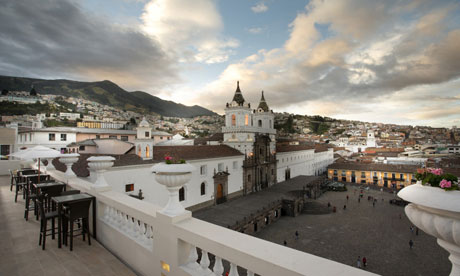
Andrés Dávila ducks into a covered market in Quito's Unesco-protected colonial centre. Aisles are laden with baskets of colourful fruit, sacks of spices and tables piled high with legs of beef.
He buys a selection of herbs from a smiling matriarch who sells greenery ranging from leaves for tempering altitude sickness to the gherkin-shaped San Pedro cactus, used in the Andes to brew a hallucinogenic soup. We're getting supplies for dinner at Casa Gangotena (+593 2 400 8000, casagangotena.com), a restored historic mansion on cobbled Plaza de San Francisco. Casa Gangotena runs culinary tours of the San Roque neighbourhood, a place tourists have been scared to visit in the past, but where guests now join Dávila to stock up on ingredients each morning.
While the food that evening isn't mind-warping, it certainly challenges the senses. We're presented with four mini-tortillas topped with salmon and accompanied by variations on aji, Ecuador's indispensable hot sauce. There's pepa de sambo (with pumpkin seeds and coriander) and another made from tomate de arbol (tomatillo). The spiciest is a Pacific coast aji made from three kinds of chilli pepper and christened pocos amigos (few friends).
Aside from being delicious, the variations of aji are a reason why the hitherto ignored culinary tradition of Ecuador – based on produce sourced from every corner of one of the world's most diverse collections of biospheres – may soon emulate the global success of other Latin American cuisines, not least neighbouring Peru, with its ceviche-led food revolution.
A two-hour drive north of Quito is Hacienda Zuleta, a 17th-century farmstead 3,050m above sea level that was once home to Galo Plaza Lasso, president of Ecuador 1948-52.
It's renowned for its food, and the quintessential Ecuadorian locro, (creamy potato soup) is as comforting as the rest of the hacienda, where log fires crackle in antique-filled rooms. More comforting still is a chicken and rice casserole, the recipe infused with South America's revolutionary past.
"It was the invention of my great-grandmother's cook, Cotito," says Fernando Polanco Plaza, the former president's grandson. "My great-grandfather was a general involved in liberal struggles. No one knew who would come for dinner or who would be in jail, so this dish emerged from leftover rice, which would be mixed at night with meat and veg and sauces."
Fernando tells me Ecuador should be punching above its weight: "For me, the stars of Latin American food are Mexico, Peru and then Ecuador, with its mega diverse ecosystems. Our food has been a secret for too long."
In another of those ecosystems – high cloud forest on the other side of Quito – is Mashpi ecolodge, a glass-walled cocoon amid a 1,000-hectare conservation project. Here, the lunchtime starter is three types of forest manioc, with shrimp. Chef David Barriga brings in encebollado, a coastal fish and onion stew that Ecuadorians swear by as a hangover cure. A manioc pancake forms a bed for the next dish – four prawns and a tender chunk of steak. It comes with a tangerine sorbet and side sauce of "snake fruit", named for its scaly skin.
Barriga is also keen to promote Ecuador's food. "We have all the raw materials Peru has, and more."
Much of this diversity can be sampled without even leaving Quito, in new upmarket eateries, mainly in the north of the city. Verde Esmeralda (Julio Zaldumbide 24, +593 2 290 0747) specialises in Afro-Ecuadorian dishes from the coast (think coconut, seafood, green banana and cassava) with mains from $8 to $14.
Elsewhere, unique takes on the country's food are being produced at two other relatively young restaurants by chefs from varied backgrounds.
At Lua (Pontevedra 24, +593 2 511 2570), Peruvian chef Alexander Lao fuses his family's Italian-Chinese heritage with local produce. Highlights include a ceviche of king prawns, red onion and tomato, which is "more citric than Peru's", says Lao.
And over at Alma (El Monitor 188, +593 2 225 2248, alma.com.ec), east of central Quito, Buenos Aires native Miguel de Arregui (son of a Basque father and a Ukrainian mother) is dishing up contemporary Argentinian cuisine with a nod to his adopted country. This is where I enjoy my last meal in Ecuador, seared lamb on quinoa couscous with vegetable ratatouille, and it left me feeling as contented as a particularly well-fed guinea pig.
• The trip was provided by Metropolitan Touring in Quito (+593 2 298 8200, metropolitantouring.com). A five-night tour with all meals costs £1,210pp. Flights with United Airlines (united.com) were provided by the Quito tourist board (quito.com.ec); Heathrow to Quito via Houston from £633 return

